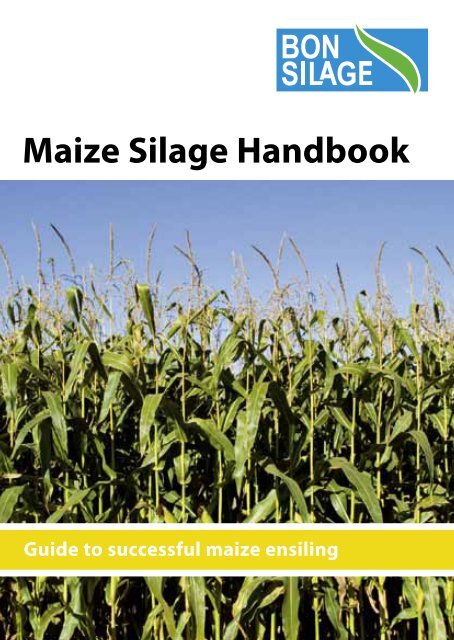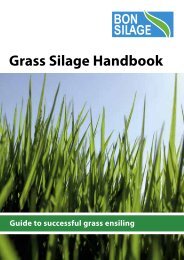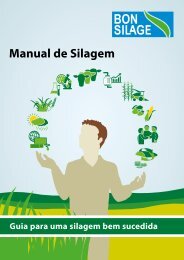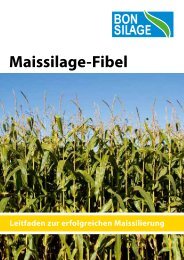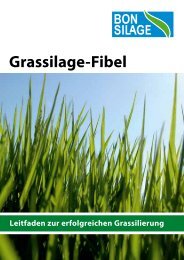You also want an ePaper? Increase the reach of your titles
YUMPU automatically turns print PDFs into web optimized ePapers that Google loves.
<strong>Maize</strong> <strong>Silage</strong> <strong>Handbook</strong><br />
Guide to successful maize ensiling
Contents<br />
Guide to successful maize ensiling<br />
1. Characteristics of maize ensiling products 3<br />
2. Harvesting time (silo maize) 4<br />
3. Chop lengths (silo maize) 5<br />
4. Effects of using silage additive 6<br />
5. Ensiling CCM/maize grain meal 8<br />
Biological ensiling 8<br />
Preserving with acids 8<br />
6. SCHAUMANN ensiling and<br />
preserving products 10<br />
7. Dosing technology 14<br />
8. Compacting and protecting 15<br />
9. Sealing and removal 16<br />
10. Silo face 17<br />
11. Economic efficiency 18<br />
12. Product range 19<br />
1. Characteristics of maize ensiling products<br />
n Low raw protein content.<br />
n Lots of fermentable carbohydrates<br />
(favourable fermenting properties).<br />
n Low buffering capacity.<br />
n High fermentability coefficient.<br />
n DM content of maize grain and corn cob products<br />
in the upper limit area of biological ensilability.<br />
n Extremely high spoilage potential<br />
(yeast and mould activity, heating up).<br />
Target values for whole plant maize silage and CCM silages:<br />
Parameter<br />
Target value<br />
Mais-TPS CCM<br />
Target value % 30-35 60-65<br />
pH value (function of DM) 3.8-4.2 3.8-4.2<br />
Starch % DM > 30 > 65<br />
XP % DM 8-9 9-10<br />
XF % DM < 20 2,5-3,5<br />
NDF % DM 35-40 10-12<br />
XA % DM < 4.5 < 2.5<br />
NH -N % of total N 3<br />
ELOS % DM<br />
< 6<br />
> 70<br />
< 6<br />
> 79<br />
Gas formation ml/200 mg DM > 52 > 54<br />
Energy density MJ NEL/kg DM > 6.5<br />
> 15.5 MJ ME (pigs)<br />
> 8.2 MJ NEL (cattle)<br />
Note: high silage quality is the basis for top production performance<br />
3
2. Harvesting time (silo maize – whole plant) 3. Chop lengths (silo maize – whole plant)<br />
Recommended harvesting time:<br />
n DM content of whole plant between 29 and 34 %.<br />
n Starch storage in the grain is completed.<br />
n High proportion of cob and readily digestible residual plant.<br />
n <strong>Maize</strong> is ready for ensiling if the dry matter in the grain has<br />
reached a value between 56 and 60 %.<br />
n As a guideline, ensiled crop should have approx. 300 g starch and<br />
40 g sugar (depending on the planned silage share of the ration).<br />
Harvesting at this recommended time will ensure:<br />
n Optimum compaction properties.<br />
n Reduced tendency to heating up and mould formation.<br />
n Less susceptibility to Fusarium toxin formation.<br />
n Good consumption properties.<br />
4<br />
Optimum: 5 to 8 mm<br />
(theoretical chop length)<br />
Following this recommendation will ensure:<br />
n Possibility of optimised compaction<br />
(more than 230 kg DM per m3 silage).<br />
n Minimal energy losses during ensiling and removal.<br />
n Increased feed intake (+ 0.7 kg DM intake/day<br />
as against 20 mm particles).<br />
n Improved digestibility (attack surface for the<br />
rumen microorganisms is increased).<br />
n The optimum chop length of 5 mm also applies<br />
to use for biogas.<br />
5
4. Effects of using silage additive<br />
Aim of using silage additive in silo maize and maize grain products<br />
n Suppression of undesirable microorganisms<br />
(Acetobacter, yeasts, mould fungi and other<br />
toxin-forming spoilage agents).<br />
n Prevention of heating up and fermentation failure.<br />
n Improved consumption properties (palatability).<br />
n Increased digestibility (substrate disintegration).<br />
n Targeted control of fermentation process<br />
(achieving defined quantities of acetic acid,<br />
propandiol and lactic acid).<br />
n Dry matter losses reduced from the usual 8-12 % to 2-3 %.<br />
Recommended silage additive (silo maize – whole plant):<br />
n BONSILAGE MAIS as the standard product.<br />
n SILOSTAR MAIS in case of reduced silo ripening time<br />
or in areas of the silo that require special protection<br />
against fermentation pests.<br />
Recommended silage additive (CCM/maize grain):<br />
n BONSILAGE CCM<br />
Optimum DM: 58-62 %<br />
Maximum DM: 65 %<br />
6<br />
BONSILAGE MAIS optimises the course of fermentation, increases<br />
the energy density and increases the aerobic stability.<br />
BONSILAGE MAIS optimises the fermentation process for more<br />
energy<br />
3.8<br />
3.8<br />
pH value<br />
1.63 %<br />
of FM<br />
2.35 %<br />
of FM<br />
Lactic acid<br />
Control BONSILAGE MAIS<br />
0.68 %<br />
of FM<br />
0.31 %<br />
of FM 0.02 %<br />
of FM<br />
Acetic acid<br />
0.31 %<br />
of FM<br />
1,2 Propandiol<br />
BONSILAGE CCM reduces yeasts and mould in maize grain<br />
meal silage, 67% DM (ISF, Wahlstedt)<br />
CFU/g<br />
1.2x10 6<br />
1.0x10 6<br />
8x10 5<br />
6x10 5<br />
4x10 5<br />
2x10 5<br />
0<br />
Yeasts<br />
Control BONSILAGE CCM<br />
Mould<br />
7
5. Ensiling CCM/maize grain meal<br />
Biological ensiling<br />
n Avoid high proportions of cob (target: < 10 %).<br />
n Degree of milling: > 80 % of particles < 2 mm.<br />
n Storage density: > 500 kg DM/m3 .<br />
n Precise application of 1 g BONSILAGE CCM in 0.5-4 litres<br />
water per tonne maize meal.<br />
n Minimum storage time: 6-8 weeks (silo ripening time).<br />
n The higher the DM content, the longer the ripening time<br />
that must be allowed.<br />
Preserving with acid<br />
Acid metering for storage in plastic:<br />
n 56-67 % DM = 5 l SCHAUMASIL EXTRA / SCHAUMASIL SUPRA NK<br />
n 67-75 % DM = 8 l SCHAUMASIL EXTRA / SCHAUMASIL SUPRA NK<br />
n If the hygiene of the starting material is compromised (e.g. smut)<br />
or in case of contamination, the measured dose should be<br />
increased by 0.1-0.3 %.<br />
8<br />
Technological tips:<br />
For successful ensiling/preservation it is important to determine<br />
the dry matter in the starting material accurately. In principle, the<br />
moisture content of each batch delivered should be determined,<br />
especially if large quantities at different stages of ripening are<br />
delivered.<br />
n Always use acid-resistant measuring containers to measure acid.<br />
n Carry out precise adjustment before using the equipment<br />
(’gauging by litres’).<br />
n Always observe the safety precautions. The specific safety data<br />
sheets for the product must be available (HACCP concept).<br />
n The walls and base of the storage unit that come into contact<br />
with the treated silage must be coated with an acid-resistant<br />
product or protected by acid-resistant sheeting.<br />
n Overheating during milling should be avoided to prevent<br />
spoilage caused by heat (browning or blackening of the<br />
maize product, Maillard reaction).<br />
9
6. Ensiling additives<br />
Active ingredients: Homofermentative and heterofermentative<br />
lactic acid bacteria<br />
Aim of use: Optimised course of fermentation, increased energy<br />
density, aerobic stability<br />
Area of use: maize whole plant silage, cereal TPS<br />
Pack size: granules 25 kg, liquid 100 g powder<br />
Dose/t: granules 0.25 kg/t ensiled material,<br />
liquid 1 g/t ensiled material<br />
Recommended compaction: at least 200 kg DM/m 3<br />
Minimum storage time: 6-8 weeks<br />
10<br />
Great silage,<br />
easy handling<br />
Group 2<br />
Nutrient protection<br />
for maize grain silage<br />
and corn cob mix<br />
Active ingredients: Homofermentative and heterofermentative<br />
lactic acid bacteria<br />
Aim of use: optimised fermentation acid pattern, more reliable<br />
energy retention, high storage stability<br />
Area of use: CCM, maize grain silage, husk cob meal<br />
Pack size: granules 25 kg, liquid 50 g powder<br />
Dose/t: granules 0.25 kg/t ensiled material,<br />
liquid 1 g/t ensiled material<br />
Recommended compaction: > 500 kg DM/m 3<br />
Minimum storage time: 6-8 weeks<br />
The biological ensiling<br />
agent for valuable cereals<br />
Active ingredients: Combination of homofermentative and<br />
heterofermentative lactic acid bacteria strains<br />
Aim of use: optimum fermentation acid spectrum, stability<br />
of milled cereal and grain maize in the silo or roll, even with<br />
higher DM contents up to 75 %.<br />
Pack size: liquid, 100 g<br />
Dose/t: liquid, 2 g<br />
Recommended compaction: > 500 kg DM/m 3<br />
Minimum storage time: at least 8 weeks<br />
Group 2<br />
11
LIQUID<br />
The turbo starter<br />
among ensiling agents<br />
Active ingredients: homofermentative and heterofermentative<br />
lactic acid bacteria strains, active ingredient additive<br />
Aim of use: accelerated silo ripeness<br />
Area of use: silo maize, TPS, CCM<br />
Dose: 1 kg granules/t ensiled material<br />
Minimum storage time: 3 weeks<br />
The liquid alternative,<br />
also for complete treatment<br />
Active ingredients: combination based on sodium benzoate<br />
and sodium acetate<br />
Aim of use: inhibiting yeasts and mould, low-loss silo surfaces;<br />
complete treatment effectively prevents heating up (non-corrosive,<br />
user-friendly)<br />
Area of use: grass, maize and cereal TPS and industrial byproducts<br />
Dose: surface treatment: 0.3-0.5 l/m2 in 10-15 cm layer thickness.<br />
Complete treatment: depending on type of silage and DM content:<br />
3-5 l/t<br />
Minimum storage time: 2 weeks<br />
12<br />
Group 2<br />
NEW<br />
PROTECT<br />
A highly effective<br />
combination for<br />
specific silo protection<br />
Aim of use: to protect the silo surface from mould and yeasts<br />
Area of use: silage surface and edge treatment<br />
Dose: 2-5 g granules/t or 200 g/m 2 (surface treatment)<br />
Active ingredients: organic acids<br />
Area of use: preservation of CCM, maize grain silage<br />
Dose: 5-8 l/t when stored in plastic sheets;<br />
8-10 l/t for maize meal not stored in plastic sheets<br />
Minimum storage time: 2 weeks<br />
Active ingredients: organic acids; buffered<br />
Area of use: preservation of CCM, maize grain silage<br />
Dose: 5-8 l/t when stored in plastic sheets;<br />
8-10 l/t for maize meal not stored in plastic sheets<br />
Minimum storage time: 2 weeks<br />
13
7. Dosing technology<br />
WEDA UED for BONSILAGE products<br />
Application: liquid<br />
Design: electronically controlled<br />
compact unit. Standard unit:<br />
2x5 l tanks for bacterial<br />
concentrate. Dosing by ultra-fine<br />
misting. Ready for operation<br />
with all accessories.<br />
Output: choice of 180 l/h<br />
or 270 l/h<br />
Drive: 12 V DC<br />
Area of use: forage harvesters<br />
Other liquid or granule dosing equipment on enquiry.<br />
SCHAUMANN acid dosing equipment<br />
SDG 450 E / SDG 800 E<br />
Application: liquid<br />
Design: self-priming pump with<br />
flow meter, 2.5 m intake hose<br />
with foot filter, 5 m delivery<br />
hose with nozzle holders and<br />
set of nozzles. All parts stainless<br />
steel, with On/Off switch and<br />
emergency switch.<br />
Output:<br />
SDG 450 E: 40-450 l/h<br />
SDG 800 E: 80-800 l/h<br />
Drive: 230 V AC<br />
Other units on enquiry, both electric and pneumatic.<br />
14<br />
8. Compacting<br />
Silo maize – whole plant<br />
n Intensive compacting = basic requirement<br />
for optimum ensiling<br />
n Layer thickness when compacting:<br />
25 to 30 cm before rolling<br />
n Slow travel (2-3 km/h) with high rolling<br />
pressure (2.5-3 bar tyre pressure)<br />
n At 28 % DM: 230 kg DM/m3 n At 33 % DM: 250 kg DM/m3 n Over 35 % DM, for each additional<br />
percentage point DM approx. 10 kg DM/m3 higher density<br />
For CCM/maize grain meal<br />
n Storage density: > 500 kg DM/m3 n A removal rate of approx. 10-15 cm per day<br />
is recommended.<br />
For the top edge and cover layers<br />
Use of organic acid mixes in liquid or dispersible form<br />
n SCHAUMASIL EXTRA<br />
(1 litre per m2 diluted with 3 litres water)<br />
n SILOSTAR PROTECT<br />
(0.2-0.5 kg per m2 or 2-5 kg/t) worked into the top layer<br />
7<br />
WRONG<br />
Projecting vehicle parts<br />
prevent rolling right<br />
up to the wall.<br />
7<br />
WRONG<br />
The angle of the tractor<br />
makes it impossible to<br />
roll right up to the wall.<br />
3CORRECT<br />
The angle allows<br />
rolling right up<br />
to the silo wall.<br />
15
9. Sealing and removal<br />
Sealing<br />
n Bottom sheet, adheres directly to the silage (thickness: 0.04 mm).<br />
n Main sheet, must be gasproof (thickness: 0.15-0.25 mm).<br />
n It is advisable to cover over temporarily during extended breaks<br />
in ensiling (6 hours or longer).<br />
n SCHAUMANN silo netting protects the sheets from mechanical<br />
damage and provides additional weighting.<br />
n SCHAUMANN silo sandbags as weighting for a snug fit.<br />
Airtight barriers can be created 5 m apart.<br />
n Side wall sheeting should be used for side walls.<br />
Removal<br />
n Minimum removal rate: cold weather: 15-20 cm/day<br />
hot weather: 30-35 cm/day<br />
n Maximum exposed silo face: 1 m2 for every 10 cows<br />
n Recommended reserve volume: 20 m3 /cow<br />
Examples of good cover:<br />
Silo sandbags<br />
Silo netting<br />
Silo sheeting<br />
Bottom sheet<br />
Edge sheet<br />
Silo sandbags<br />
Drivable silo <strong>Silage</strong> clamp<br />
16<br />
10. Silo face<br />
The minimum removal rate to avoid heating up should be 1.5 m per<br />
week in winter and 2.5 m per week in summer. The removal technique<br />
should be designed to do as little damage as possible to the exposed<br />
face and to minimise air ingress.<br />
Eff ects of removal technique on silo face temperature<br />
(after 20 hours, 20 cm back from the face)<br />
Temperature (°C)<br />
23<br />
22<br />
21<br />
20<br />
19<br />
18<br />
17<br />
16<br />
Block cutter Cutting plate with<br />
movable knives fixed knives<br />
Preventing heating up<br />
n Create summer silos with a smaller silo face.<br />
n Do not have the face of the silo facing into the prevailing wind.<br />
n Leave the silo sheet in place until near the time of silage removal.<br />
n Calculate the silo length and removal rate according to the herd size.<br />
n Optimise the removal technique.<br />
Air fl ow in an open silo<br />
Reserve<br />
<strong>Silage</strong> cutter Tined bucket Rotary cutter<br />
Atmospheric oxygen<br />
Heat<br />
CO2 H2O Note: to avoid heating up, the silo face should be adapted to the<br />
requirements of the farm.<br />
Source: Steinhöfel and Pahlke, 2005<br />
17
11. Economic efficiency<br />
On the winning side<br />
with BONSILAGE MAIS Group 2<br />
A model calculation has been used to illustrate the increased<br />
economic efficiency of maize silage production using<br />
BONSILAGE MAIS as an ensiling agent.<br />
Harvest yield: 50 t fresh matter per hectare with 35 % DM<br />
equivalent to 17.5 t dry matter per hectare<br />
Energy content: silo maize, start of dough-ripe stage,<br />
high proportion of cob: 6.7 MJ NEL/kg DM<br />
The energy yield in MJ NEL/ha is increased by using<br />
BONSILAGE MAIS<br />
DM losses cut by 8% when using BONSILAGE MAIS.<br />
The higher energy content of maize silage<br />
with BONSILAGE MAIS is disregarded. 1 kg milk = 3.3 MJ NEL<br />
Control BONSILAGE MAIS<br />
Energy Milk Energy Milk<br />
MJ NEL/ha kg/ha MJ NEL/ha kg/ha<br />
Harvest yield 117,250 35,530 117,250 35,530<br />
Losses 15,242 4,619 5,862 1,776<br />
Yield 102,007 30,911 111,388 33,754<br />
Increased yield + 9,381 + 2,843<br />
Potential challenge feeding saving<br />
Potential challenge feeding saving<br />
(challenge feeding with 7.0 MJ NEL/kg)<br />
9.381 ÷ 7 = 1.340 kg<br />
Cost reduction with ch. feed prices of 17 €/dt 24 €/dt<br />
228 € 322 €<br />
Ensiling agent cost - 59 €/ha - 59 €/ha<br />
Additional yield with<br />
BONSILAGE MAIS<br />
18<br />
+169 €/ha + 268 €/ha<br />
12. Product range<br />
PROTECT<br />
LIQUID<br />
BONSILAGE<br />
The basic product for all types of green silage.<br />
Rapid lowering of pH value.<br />
BONSILAGE PLUS<br />
For the upper DM range of all types of green silage.<br />
Improved stability and digestibility.<br />
BONSILAGE FORTE<br />
For the lower DM range of all types of green silage.<br />
Inhibits Clostridia.<br />
BONSILAGE EXTRA<br />
For all types of green silage with a high proportion<br />
of sugar-rich grasses.<br />
BONSILAGE MAIS<br />
For maize silage and TPS.<br />
Improved stability and digestibility.<br />
BONSILAGE CCM<br />
For maize grain meal and CCM. Protects against<br />
uncontrolled yeast multiplication.<br />
BONSILAGE GRAIN<br />
The biological solution for wet<br />
milled cereals.<br />
SILOSTAR MAIS<br />
Biological/chemical ensiling agent for maize,<br />
CCM and TPS. Shortens the silo ripening time.<br />
SILOSTAR PROTECT<br />
For surface and edge treatment. Inhibits yeast<br />
and mould fungi at the edges.<br />
SILOSTAR LIQUID<br />
The liquid chemical alternative, also for<br />
complete treatment.<br />
Group 1b<br />
Groups 1c, 2, 4b<br />
Groups 1b, 5a<br />
NEW<br />
Group 2<br />
Group 2<br />
NEW<br />
Group 2<br />
NEW<br />
19
Schaumann Agri International GmbH<br />
An der Mühlenau 4 · D-25421 Pinneberg · Germany<br />
Phone +49 41 01/2 18-53 00 · Fax +49 41 01/2 18-53 99<br />
info@schaumann-agri.com · www.schaumann.info<br />
Schaumann Agri Austria GmbH & Co. KG<br />
Jakob Fuchs-Gasse 25-27 · A-2345 Brunn am Gebirge · Austria<br />
Phone +43 22 36/3 16 41 · Fax +43 22 36/3 16 41-50<br />
agriaustria@schaumann.at · www.schaumann.info<br />
100311GB


